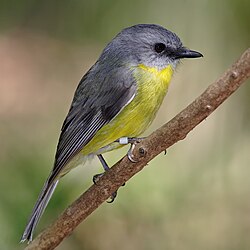Songbird
Songbirds are the main group of birds in the order Passeriformes. They are the suborder Passeri, sometimes called 'oscines' (Latin for songbird). They are a genuine clade.
| Songbirds Temporal range: early Eocene to present
| |
|---|---|

| |
| Eastern yellow robin (Eopsaltria australis) | |
| Scientific classification | |
| Kingdom: | |
| Phylum: | |
| Class: | |
| Order: | |
| Suborder: | Passeri
|
There are about 4000 species of songbird. Their syrinx (vocal organ) is able to produce varied and beautiful singing.[1] They are a very successful group of birds, in fact they are the dominant birds on Earth today.
It seems songbirds evolved 50 million years ago in the part of Gondwana which later became Australia, New Zealand, New Guinea and Antarctica. They then spread around the world.[2][3]
Song
Their song is mainly territorial: it communicates the identity and whereabouts of an individual to other birds of the same species. It also signals sexual intentions. Female preference in some populations is based on the extent of a male's song repertoire. The larger a male's repertoire, the more females a male individual attracts.[4]
Bird calls are also used for alarms and contact. They are especially important in birds that feed or migrate in flocks. Although almost all birds give calls of some sort, well-developed songs are only given by a few lines outside the songbirds.
Families
Corvida
This is now known to be a paraphyletic group and so it is not used in modern systematics.
- Menuridae
- Bowerbirds and Australian treecreepers
- Ptilonorhynchidae: bowerbirds
- Climacteridae: Australian treecreepers
- Meliphagoidea: honeyeaters and allies
- Maluridae: fairy-wrens, emu-wrens and grasswrens
- Meliphagidae: honeyeaters and chats
- Acanthizidae: pardalotes, scrubwrens, thornbills, and gerygones
- Australopapuan babblers
- Pomatostomidae: Australasian babblers
- Logrunners
- Other basal lines
- Cinclosomatidae: whipbirds and allies
- Neosittidae: sittellas
- Pachycephalidae: whistlers, shrike-thrushes, pitohuis and allies
- Dicruridae: monarch flycatchers and allies
- Campephagidae: cuckoo shrikes and trillers
- Oriolidae: orioles including figbird
- Artamidae: woodswallows, butcherbirds, currawongs and Australian magpie
- Paradisaeidae: birds of paradise
- Corvidae: crows, rooks, ravens, magpies, and jays
- Corcoracidae: white-winged chough and apostlebird
- Irenidae: fairy-bluebirds
- Laniidae: shrikes
- Vireonidae: vireos
Passerida
This is accepted as a clade.
- Petroicidae: Australian robins
- Alaudidae: larks
- Chloropseidae: leafbirds
- Aegithinidae: ioras
- Picathartidae: rockfowl
- Eupetidae: rail-babbler
- Bombycillidae: waxwings and allies
- Ptilogonatidae: silky flycatchers
- Cinclidae: dippers
- Motacillidae: wagtails and pipits
- Prunellidae: accentor
- Melanocharitidae: berrypeckers and longbills
- Paramythiidae: tit berrypecker and crested berrypeckers
- Passeridae: true sparrows
- Estrildidae: estrildid finches (waxbills, munias, etc.)
- Parulidae: New World warblers
- Thraupidae: tanagers and allies
- Peucedramidae: olive warbler
- Fringillidae: true finches
- Cardinalidae: cardinals
- Drepanididae: Hawaiian honeycreepers
- Emberizidae: buntings and American sparrows
- Nectariniidae: sunbirds
- Dicaeidae: flowerpeckers
- Mimidae: mockingbirds and thrashers
- Sittidae: nuthatches
- Certhiidae: treecreepers
- Troglodytidae: wrens
- Polioptilidae: gnatcatchers
- Paridae: tits, chickadees and titmice
- Aegithalidae: long-tailed tits
- Hirundinidae: swallows and martins
- Regulidae: kinglets
- Pycnonotidae: bulbuls
- Phylloscopidae: leaf-warblers and allies. Recently split from Sylviidae.
- Sylviidae: Old World warblers
- Hypocoliidae: Hypocolius
- Cisticolidae: cisticolas and allies
- Icteridae: American blackbirds, New World orioles, grackles and cowbirds.
- Zosteropidae: white-eyes
- Timaliidae: babblers
- Muscicapidae: Old World flycatchers and chats
- Turdidae: thrushes and allies
- Sturnidae: starlings
References
- ↑ There are some exceptions, the crow family, for example.
- ↑ Barker F.K. et al 2004. Phylogeny and diversification of the largest avian radiation. PNAS 101(30): 11040-11045.
- ↑ Low T. 2014. Where song began: Australia's birds and how they changed the world. Penguin Australia.
- ↑ Byers, B.E. and D.E. Kroodsma 2008. Female mate choice and songbird song repertoires. The Association for the Study of Animal Behavior 77: 13-22.
Other websites
| Wikispecies has information on: Passeri. |
- Oscines Tree of Life web project article July 31, 2006
- Pictures of Songbirds